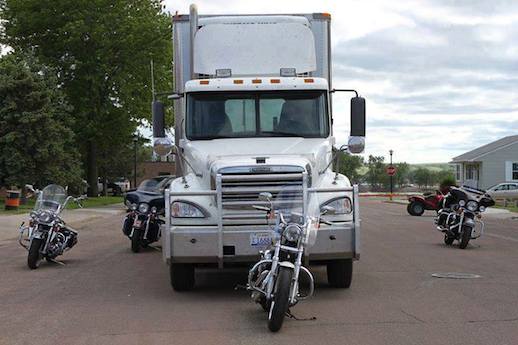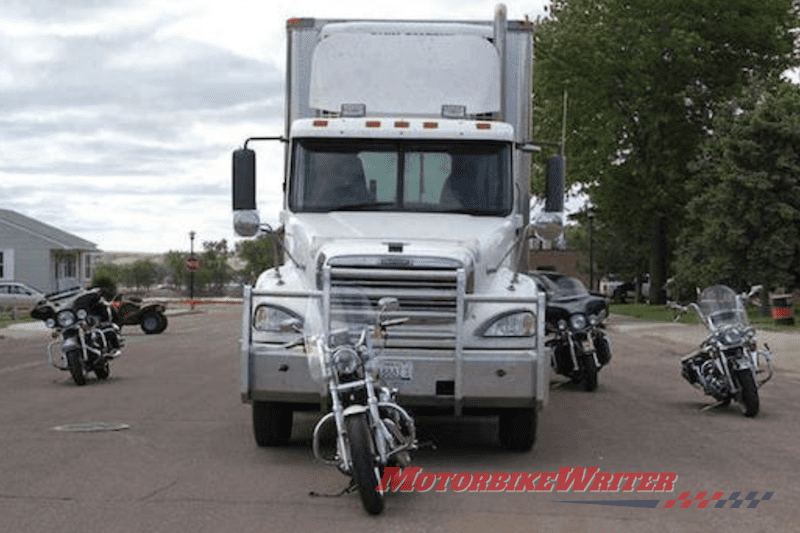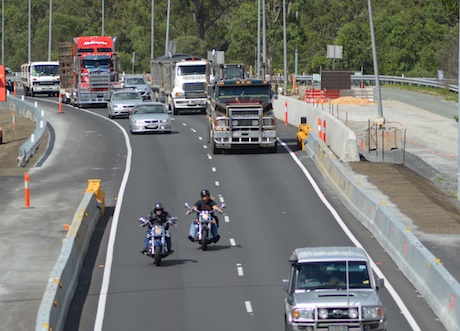Lane filtering around trucks can be dangerous simply because riders can be invisible to the truck driver, even if you are right in front!
This video quite clearly shows the danger of stopping right in front of a truck.
The Goldwing World Facebook page also published the above photograph claiming all the bikes in the photo are in the truck’s blind spots.
(For right-hand-drive nations the image has been reversed below.)
Notice that one of the positions where riders cannot be seen is right in front of the truck.
I have witnessed riders filter to the front of a line of traffic and then move across to sit in the lane in front of a prime mover.
The truck driver could be totally unaware of the presence of the rider.
So if the rider stalls when the lights turn green, what’s stopping the driver from running over the top of you if you happen to stall?
Or if the rider is distracted and misses the change of lights and the truckie is keen to get going … splat!
Lane filtering rules
Despite the dangers of trucks to lane filtering riders, only the ACT prohibits lane filtering next to buses and trucks.
There is no mention in the official lane filtering rules for Queensland, NSW, SA, Victoria or Tasmania.
However, they all suggest in their explanatory notes riders “should avoid” filtering next to buses and heavy vehicles.
It should also be noted that an overriding rule is that riders must lane filter only “when safe to do so” (or similar words).
This is mentioned in Victoria, SA, ACT, Queensland and Tasmania, but not NSW,
It not only puts the onus on the rider to act responsibly and safely, but also provides police with some latitude to fine riders based on their judgement.
Onus on trucks
While riders should always take responsibility for their own safety, there is also an onus on truck drivers and other motorists to share the road with all vehicles, including motorcycles.
London has taken it further, banning trucks (lorries) over 3.5 tonnes that do not have special extended mirrors to reduce blind spots.
Drivers with a non-complaint vehicle face a £50 Fixed Penalty Notice and potential fine of £1000 in the Magistrates Court.
Similar legislation would be most welcome here in Australia.
RACQ safety officer and Suzuki Bandit fan Steve Spalding says blind spots around large vehicles are “a very risky situation for riders”.
“If there are ways to improve the types of mirrors fitted, or have better placement of existing ones, then we’d like to see heavy vehicle operators make those changes,” he says.
“Riders have to be aware of their vulnerability at all times but particularly when in congested traffic and around large and heavy vehicles because it can be difficult for truck drivers to cover all the blind spots.”
However, the truck mirror legislation would not have helped the London rider in this video which has gone viral. He was in front of the driver!
More blind spots
One of the big problems with riding near trucks, buses and other big vehicles is that their blind sports are not the same.
Fixed vehicles such as vans and buses/coaches have different blind spots to B doubles or prime movers with trailers. There are also extra blind spots for trucks with hoods (eg Mack) rather than cab-over trucks (eg Hino) with flat fronts.
We spoke with several bus and truck drivers and they say they don’t have a lot of problems with riders, but agree that there is potential for riders to get lost in blind spots.
For fixed vehicles, the worst blind spot is close on the inside (left in RHD countries and right for LHD countries) of the vehicle. Most heavy vehicles have blind-spot mirrors, but fast-accelerating bikes can zoom into view so quickly on a slow-moving vehicle, the driver may not have had a chance to see them.
Prime movers also have the problem that when they turn, their mirrors, which are fixed to the prime mover, show only a view of the trailer on one side and a wide view on the other, creating a massive blind spot area.
For trucks with a big bonnet, almost every near position from the mirrors forward is a blind spot, especially by the inside fender.
Drivers say riders can slip into the gap in front of a truck without them seeing the bike, which could result in a rear-ender as they approach a red traffic light.
They also claim that when the lights turn green, a gap opens up in front of slow-moving trucks and riders tend to slip into that gap where they may not be seen.
Wide berth
Motorcycles need to give trucks a wide berth on all angles in all traffic situations.
And don’t hope that your loud exhaust will alert the truck driver to your presence.
Most truck cabins are loud because the driver is sitting over the engine and is probably playing music or their CB radio over the top.
They will not hear you until you have passed them.
Sucked in
Bus and truck drivers also warn about the aerodynamic effects of following and riding too close to their vehicles.
Vehicles such as buses and some trailers with carriages low to the ground tend to create a vacuum at highway speeds that can suck a light bike toward them and potentially under their wheels.
Other trailers can push riders away into oncoming traffic. Some trailers, such as those carrying vehicles, create so much turbulence it can send a light bike into a tank slapper.
The effect is worse if the rider follows too closely before overtaking as they cop a sudden blast as they draw up alongside.
Oakey truckie Brad Shannon advises: “If you can see our mirrors we should be able to see you. But I always look twice, anyway.”






